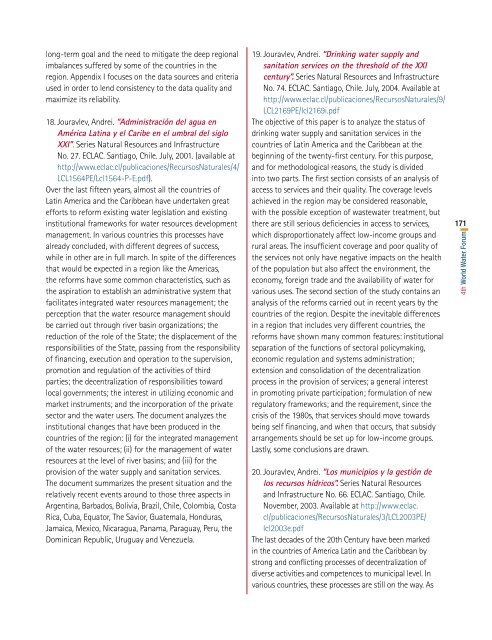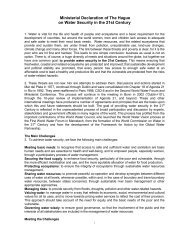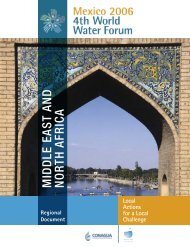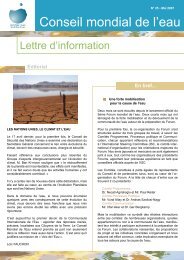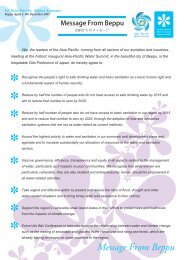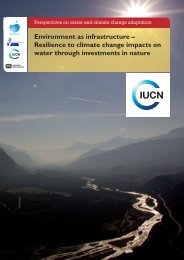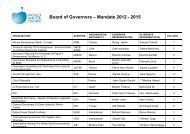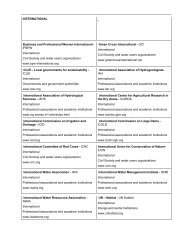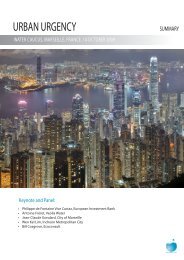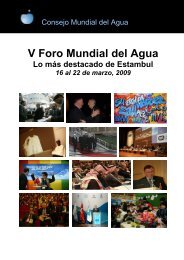Americas ok.indd - World Water Council
Americas ok.indd - World Water Council
Americas ok.indd - World Water Council
Create successful ePaper yourself
Turn your PDF publications into a flip-book with our unique Google optimized e-Paper software.
long-term goal and the need to mitigate the deep regionalimbalances suffered by some of the countries in theregion. Appendix I focuses on the data sources and criteriaused in order to lend consistency to the data quality andmaximize its reliability.18. Jouravlev, Andrei. “Administración del agua enAmérica Latina y el Caribe en el umbral del sigloXXI”. Series Natural Resources and InfrastructureNo. 27. ECLAC. Santiago, Chile. July, 2001. (available athttp://www.eclac.cl/publicaciones/RecursosNaturales/4/LCL1564PE/Lcl1564-P-E.pdf).Over the last fifteen years, almost all the countries ofLatin America and the Caribbean have undertaken greatefforts to reform existing water legislation and existinginstitutional frameworks for water resources developmentmanagement. In various countries this processes havealready concluded, with different degrees of success,while in other are in full march. In spite of the differencesthat would be expected in a region like the <strong>Americas</strong>,the reforms have some common characteristics, such asthe aspiration to establish an administrative system thatfacilitates integrated water resources management; theperception that the water resource management shouldbe carried out through river basin organizations; thereduction of the role of the State; the displacement of theresponsibilities of the State, passing from the responsibilityof financing, execution and operation to the supervision,promotion and regulation of the activities of thirdparties; the decentralization of responsibilities towardlocal governments; the interest in utilizing economic andmarket instruments; and the incorporation of the privatesector and the water users. The document analyzes theinstitutional changes that have been produced in thecountries of the region: (i) for the integrated managementof the water resources; (ii) for the management of waterresources at the level of river basins; and (iii) for theprovision of the water supply and sanitation services.The document summarizes the present situation and therelatively recent events around to those three aspects inArgentina, Barbados, Bolivia, Brazil, Chile, Colombia, CostaRica, Cuba, Equator, The Savior, Guatemala, Honduras,Jamaica, Mexico, Nicaragua, Panama, Paraguay, Peru, theDominican Republic, Uruguay and Venezuela.19. Jouravlev, Andrei. “Drinking water supply andsanitation services on the threshold of the XXIcentury”. Series Natural Resources and InfrastructureNo. 74. ECLAC. Santiago, Chile. July, 2004. Available athttp://www.eclac.cl/publicaciones/RecursosNaturales/9/LCL2169PE/lcl2169i.pdfThe objective of this paper is to analyze the status ofdrinking water supply and sanitation services in thecountries of Latin America and the Caribbean at thebeginning of the twenty-first century. For this purpose,and for methodological reasons, the study is dividedinto two parts. The first section consists of an analysis ofaccess to services and their quality. The coverage levelsachieved in the region may be considered reasonable,with the possible exception of wastewater treatment, butthere are still serious deficiencies in access to services,which disproportionately affect low-income groups andrural areas. The insufficient coverage and poor quality ofthe services not only have negative impacts on the healthof the population but also affect the environment, theeconomy, foreign trade and the availability of water forvarious uses. The second section of the study contains ananalysis of the reforms carried out in recent years by thecountries of the region. Despite the inevitable differencesin a region that includes very different countries, thereforms have shown many common features: institutionalseparation of the functions of sectoral policymaking,economic regulation and systems administration;extension and consolidation of the decentralizationprocess in the provision of services; a general interestin promoting private participation; formulation of newregulatory frameworks; and the requirement, since thecrisis of the 1980s, that services should move towardsbeing self financing, and when that occurs, that subsidyarrangements should be set up for low-income groups.Lastly, some conclusions are drawn.20. Jouravlev, Andrei. “Los municipios y la gestión delos recursos hídricos”. Series Natural Resourcesand Infrastructure No. 66. ECLAC. Santiago, Chile.November, 2003. Available at http://www.eclac.cl/publicaciones/RecursosNaturales/3/LCL2003PE/lcl2003e.pdfThe last decades of the 20th Century have been markedin the countries of America Latin and the Caribbean bystrong and conflicting processes of decentralization ofdiverse activities and competences to municipal level. Invarious countries, these processes are still on the way. As1714th <strong>World</strong> <strong>Water</strong> Forum


